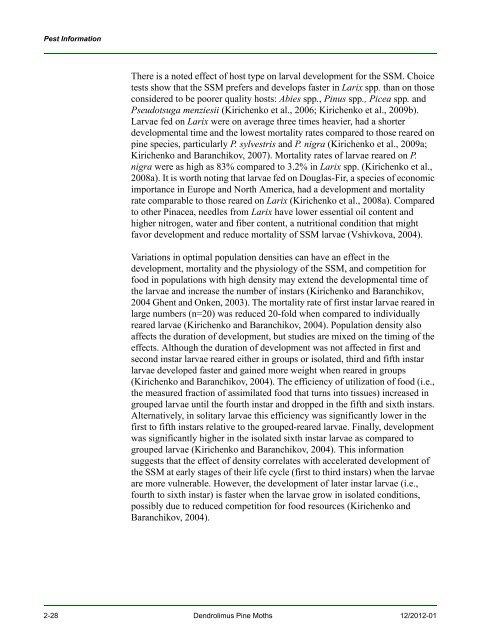New Pest Response Guidelines - aphis - US Department of Agriculture
New Pest Response Guidelines - aphis - US Department of Agriculture
New Pest Response Guidelines - aphis - US Department of Agriculture
You also want an ePaper? Increase the reach of your titles
YUMPU automatically turns print PDFs into web optimized ePapers that Google loves.
<strong>Pest</strong> Information<br />
There is a noted effect <strong>of</strong> host type on larval development for the SSM. Choice<br />
tests show that the SSM prefers and develops faster in Larix spp. than on those<br />
considered to be poorer quality hosts: Abies spp., Pinus spp., Picea spp. and<br />
Pseudotsuga menziesii (Kirichenko et al., 2006; Kirichenko et al., 2009b).<br />
Larvae fed on Larix were on average three times heavier, had a shorter<br />
developmental time and the lowest mortality rates compared to those reared on<br />
pine species, particularly P. sylvestris and P. nigra (Kirichenko et al., 2009a;<br />
Kirichenko and Baranchikov, 2007). Mortality rates <strong>of</strong> larvae reared on P.<br />
nigra were as high as 83% compared to 3.2% in Larix spp. (Kirichenko et al.,<br />
2008a). It is worth noting that larvae fed on Douglas-Fir, a species <strong>of</strong> economic<br />
importance in Europe and North America, had a development and mortality<br />
rate comparable to those reared on Larix (Kirichenko et al., 2008a). Compared<br />
to other Pinacea, needles from Larix have lower essential oil content and<br />
higher nitrogen, water and fiber content, a nutritional condition that might<br />
favor development and reduce mortality <strong>of</strong> SSM larvae (Vshivkova, 2004).<br />
Variations in optimal population densities can have an effect in the<br />
development, mortality and the physiology <strong>of</strong> the SSM, and competition for<br />
food in populations with high density may extend the developmental time <strong>of</strong><br />
the larvae and increase the number <strong>of</strong> instars (Kirichenko and Baranchikov,<br />
2004 Ghent and Onken, 2003). The mortality rate <strong>of</strong> first instar larvae reared in<br />
large numbers (n=20) was reduced 20-fold when compared to individually<br />
reared larvae (Kirichenko and Baranchikov, 2004). Population density also<br />
affects the duration <strong>of</strong> development, but studies are mixed on the timing <strong>of</strong> the<br />
effects. Although the duration <strong>of</strong> development was not affected in first and<br />
second instar larvae reared either in groups or isolated, third and fifth instar<br />
larvae developed faster and gained more weight when reared in groups<br />
(Kirichenko and Baranchikov, 2004). The efficiency <strong>of</strong> utilization <strong>of</strong> food (i.e.,<br />
the measured fraction <strong>of</strong> assimilated food that turns into tissues) increased in<br />
grouped larvae until the fourth instar and dropped in the fifth and sixth instars.<br />
Alternatively, in solitary larvae this efficiency was significantly lower in the<br />
first to fifth instars relative to the grouped-reared larvae. Finally, development<br />
was significantly higher in the isolated sixth instar larvae as compared to<br />
grouped larvae (Kirichenko and Baranchikov, 2004). This information<br />
suggests that the effect <strong>of</strong> density correlates with accelerated development <strong>of</strong><br />
the SSM at early stages <strong>of</strong> their life cycle (first to third instars) when the larvae<br />
are more vulnerable. However, the development <strong>of</strong> later instar larvae (i.e.,<br />
fourth to sixth instar) is faster when the larvae grow in isolated conditions,<br />
possibly due to reduced competition for food resources (Kirichenko and<br />
Baranchikov, 2004).<br />
2-28 Dendrolimus Pine Moths 12/2012-01

















